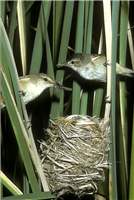Family
Sylviidae
Genus
Acrocephalus
Species
stentoreus
Threats/Control Methods - Regional
The Commonwealth Government is currently working to control the feral pigs across the region through a specialised abatement plan, hoping to decrease the risks to native species and their habitats, such as the Clamorous Reed-Warbler. Prolonged droughts will also impact upon this water dwelling bird.v
Threats/Control Methods - Local
Water bodies in urban areas are less resilient against periods of droughts or extreme weather events, causing a build-up of toxins and dangerous algae levels, which may impact the health of this species. For example, Jerrabomberra Creek Catchment is currently degraded from grazing, polluted stormwater from the Hume industrial estate, road surface runoff and rural residential developments.
Local/Urban Actions
Joining in a revegetation project around waterways with a local Landcare group can improve the vegetation available for this species. Urban water bodies will maintain better health if storm water is kept unpolluted. At home, it is important avoid chemicals, pet faeces or garden waste going down the stormwater drain. Keep gutters clean and call the Canberra Connect helpline on (02) 6207 9777 for specific chemical waste disposal information.
Common Names
Clamorous Reed-Warbler, Australian Reed-Warbler, Long-billed Reed-Warbler, Reed-lark
Distinguishing Features
This species is best known for its song, rising from thick reed beds across the country. It is a fairly small bird of 16-17cm, with an all brown appearance. Its head, back, wings and tail are darker brown, while the underparts are lighter. It has a brown eye and a pale cream eyebrow. When in full song, the bird lifts the feathers on its crown to make a slight peak.
Survey Techniques
Call and visual identification.
Species Call
A rich, powerful and slightly metallic song of 'quitt-kwitchy-kwarty' or a sharp scold.
Similar Species
The Oriental Reed-Warbler (Acrocephalus orientalis) is a sightly larger bird with similar colourings. It is only found in some coastal areas of Australia and has a much less melodic song.
Distribution
The Clamorous Reed-Warbler is found across most of Australia, moving from north to south seasonally. It is not found in the arid regions of SA and WA.
Country of Origin
Australia
Conservation (Pet/Pest) Status - Regional
The number of birds to the Canberra region peaks in November and quickly decreases again, with most birds congregating around Lake Burley Griffin and at the Jerrabomberra Wetlands.
Conservation (Pet/Pest) Status - National
Secure, not listed under the EPBC Act 1999.
LSCCES Population
Four sightings were made at both ANU and Civic West.
Associated vegetation community
This species is found in the long grass and reeds around wetlands and lakes, especially in cumbungi (Typha), bamboo thickets or lantana.
Limiting Resources
Thick reeds around a waterbody are an essential habitat for this species. Areas free from introduced, ground dwelling predators are especially important over the breeding season.
Breeding
The Clamorous Reed-Warbler breeds from September to February. It builds a deep cup in the stems of dense reeds, about 0.5 to one metre above the water. The nest is woven into the reeds with fine strips of vegetation to stop them from sliding, and the cup narrows at the top to prevent the 3-4 eggs from rolling out when the reeds sway in the wind. The eggs are small and white with brown spots, requiring 14-15 days of incubation by the female. The young leave the nest about 14-16 days after hatching.
Behaviour
This species moves into the Canberra region over the summer months for the breeding season. It is usually the spirited song of this species that reveals its presence, as it is usually well hidden amongst thick reeds. A singing bird will perch on a stem and puff out its feathers and crown. It can be sighted if it climbs along the stems of the outer reeds, or if it makes a quick flight across the water.
Functional Group
Food Species
The small birds eat a range of insects found around the water and some very small aquatic animals.
Predators
This species in prone to attacks from any predator that can squeeze or force through the thick rushes into their nesting territory. This may include Black Rats (Rattus Rattus) and Feral Pigs (Sus Scrofa).
Interesting Fact
The breeding territories of the Clamorous Reed-Warbler are very tiny and the birds must sing constantly to maintain them.
References - (reader suitability of references, P=Primary teachers, S=Secondary students, T=Tertiary students and researchers)
Books:Morcombe, M. 2000. Field Guide to Australian Birds. Steve Parish Publishing. Archerfield. Australia P, S, T
Schodde, R. and Tideman, S. (eds) 1990. Reader's Digest Complete Book of Australian Birds (2nd Edition). Reader's Digest Services Pty Ltd. Sydney. P, S, T
Taylor, M. and Day, N. 1993. Field Guide to the Birds of the ACT. National Park Association of the ACT Inc. Canberra. P, S, T
Internet: Canberra Ornithological Group (COG). 2004. Birds of Canberra Gardens. COG and the ACT Department of Urban Services. [online]. Available at:http://garden.canberrabirds.org.au/ P, S, T
Online Publications: ACT Government. 2006. Information Sheet: Stormwater Pollution from Residential Areas. Environment ACT. [online]. Available at: http://www.environment.act.gov.au/__data/assets/pdf_file/13168/Stormwater_Pollution_from_Residential_Areas.pdf P, S, T
Department of Environment and Heritage. 2004. The feral pig (Sus Scrofa). The Australian Government. Canberra. [online]. Available at: http://www.environment.gov.au/biodiversity/invasive/publications/pig/index.htmlP, S, T
Nix, H. and Cunningham, R. 2006. Birds of the Lower Sullivans Creek Catchment, Canberra ACT. Prepared for the Life in the Suburbs project using data from the Lower Sullivans Creek Catchment Ecological Survey (LSCCES). Australian National University. Canberra. [online]. Available at: http://www.lifeinthesuburbs.com.au/category.php?id=65 S, T
Queanbeyan City Council. 2004. Study on the Current State of Jerrabomberra Creek . Maunsell Australia Pty Ltd. Canberra. [online]. Available at: http://www.qcc.nsw.gov.au/Documents/YRJTKVCEDKP.pdf S, T

 Top
Top Top
Top